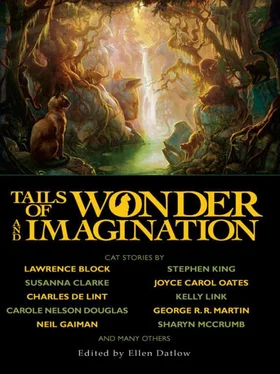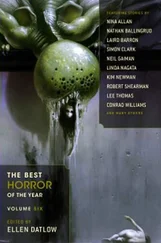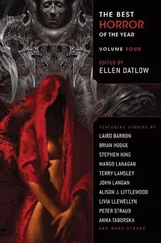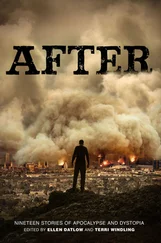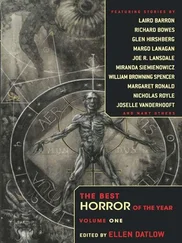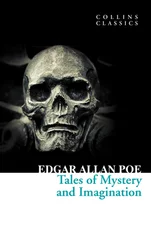Ellen Datlow - Tails of Wonder and Imagination
Здесь есть возможность читать онлайн «Ellen Datlow - Tails of Wonder and Imagination» весь текст электронной книги совершенно бесплатно (целиком полную версию без сокращений). В некоторых случаях можно слушать аудио, скачать через торрент в формате fb2 и присутствует краткое содержание. Год выпуска: 2010, ISBN: 2010, Издательство: Night Shade Books, Жанр: Фэнтези, Фантастика и фэнтези, Ужасы и Мистика, на английском языке. Описание произведения, (предисловие) а так же отзывы посетителей доступны на портале библиотеки ЛибКат.
- Название:Tails of Wonder and Imagination
- Автор:
- Издательство:Night Shade Books
- Жанр:
- Год:2010
- ISBN:978-1-59780-170-6
- Рейтинг книги:5 / 5. Голосов: 1
-
Избранное:Добавить в избранное
- Отзывы:
-
Ваша оценка:
- 100
- 1
- 2
- 3
- 4
- 5
Tails of Wonder and Imagination: краткое содержание, описание и аннотация
Предлагаем к чтению аннотацию, описание, краткое содержание или предисловие (зависит от того, что написал сам автор книги «Tails of Wonder and Imagination»). Если вы не нашли необходимую информацию о книге — напишите в комментариях, мы постараемся отыскать её.
collects the best of the last thirty years of science fiction and fantasy stories about cats from an all-star list of contributors.
Tails of Wonder and Imagination — читать онлайн бесплатно полную книгу (весь текст) целиком
Ниже представлен текст книги, разбитый по страницам. Система сохранения места последней прочитанной страницы, позволяет с удобством читать онлайн бесплатно книгу «Tails of Wonder and Imagination», без необходимости каждый раз заново искать на чём Вы остановились. Поставьте закладку, и сможете в любой момент перейти на страницу, на которой закончили чтение.
Интервал:
Закладка:
From behind his Oakleys, Craig checked out the terrace: people-watching, with a purpose for once. News of the disappearances clearly wasn’t putting these tourists off coming to Zanzibar. Mainly because there wasn’t any news. Not enough of a problem in any one country to create a crisis. One weeping family from Sutton Coldfield—“Sarah just wouldn’t go off with anyone, she’s not that kind of girl”; a red-eyed single mother from Strathclyde—“There’s been no word from Louise for three weeks now.” It wasn’t enough to get the tabloids interested and the broadsheets wouldn’t pick up on it until they were sure there was a real story. A big story. No news was no news and, by and large, didn’t make the news.
Craig had latched on to Sarah’s story following an impassioned letter to the editor of his paper from the missing girl’s mother. He was a soft touch, he told his commissioning editor: couldn’t bear to think of those good people sitting on the edge of their floral-pattern IKEA sofa, waiting for the phone to ring, weeping—especially not in Sutton Coldfield. But MacNeill, who’d been commissioning pieces from Craig for three years, knew the young man only attached himself to a story if there was a story there. And since he was between desk assignments anyway, MacNeill let him go. On the quiet, like. Neither the Tanzanian government nor the Zanzibari police would acknowledge the problem—too damaging to the developing tourism industry, ironically—so Craig needed a cover, which Craig’s sister, the wildlife photographer, came up with.
The Zanzibar leopard, smaller than the mainland species, was rumoured by some to be extinct and by others to be around still, though in very small numbers. One of the guide books reckoned if there were any on the islands, they had been domesticated by practitioners of herbal medicine—witch doctors to you and me. The Zanzibari driver who collected Craig from the airport laughed indulgently at the idea. And Craig read later in another guide book that witchcraft was believed to be widely practised on Pemba Island, 85 kilometres to the north of Zanzibar though part of the same territory. Though if you tried to speak to the locals about it, they became embarrassed or politely changed the subject. But that was Pemba, and the disappearances—37 to date, according to Craig’s researches—were quite specifically from Zanzibar Island.
Thirty-seven. Twenty-three women between 17 and 30, and 14 men, some of them older, mid-forties. From Denmark, Germany, Austria, Britain, France, Italy, Australia and the US. Enough of a problem as far as Craig was concerned. He was torn now, he was ashamed to admit, between wanting the world to wake up and make a concerted effort (thereby, hopefully, securing the earlier recovery of Sarah, or Sarah’s body, and 36 others) and hoping he would be the first to break the story.
The cover. A naturalist based at the University of Sussex, Craig’s brief was to confirm whether or not leopards still lived wild on the island. They’d even put Sussex’s professor of zoology in the picture, for a consideration of course which they called a consultancy fee, so that if anyone called from Zanzibar to check up on Craig, they’d find him to be bona fide.
That afternoon, Craig had visited the Natural History Museum, quite the bizarrest of its type in his experience. Glass cases full of birds, presumably stuffed birds, but not mounted—lying down, recently-dead-looking, their little feet tied together with string. Tags to identify them. Their eyes dabs of chalk. In a grimy case all on its own, the bones of a dodo wired up into a standing position. A couple of stuffed bats—the American Fruit Bat and the Pemba Fruit Bat—ten times the size of the swallow-like creatures that had flitted about his head as he’d walked off his dinner the evening before. A crate with its lid ajar: when he opened it, a flurry of flies, one he couldn’t prevent going up his nose. Inside, a board with three rats fixed to it—dead again, stuffed presumably, but with legs trussed at tiny rodent ankles. No effort made to have them assume lifelike poses. No bits of twig and leaf. No glass eyes. No glass case. He dropped the crate lid.
Oddest of all: row upon row of glass jars containing dead sea creatures and deformed animal foetuses, the glass furred up with dust and calcified deposits, so you had to bend down and squint to make out the bloodless remains of a stonefish, the huge crab with the image on its shell of two camels with their masters. The conjoined duiker antelopes.
And the stuffed leopard. They hadn’t done a great job on it. The taxidermist’s task being to stage a magic show for eternity: the illusion of life in the cock of the head, the setting of a glassy twinkle. The Natural History Museum of Zanzibar should have been asking for their money back on this one. You could still see it was a leopard though. If you didn’t know, you’d look at it and you’d say leopard. Craig examined it from every angle. This was what he was here to find. Ostensibly. It couldn’t do any harm to have a good idea what one looked like.
Up on the terrace, the touts were working the crowd—slowly, carefully, with a lower-key approach than they tended to use down in Stone Town. In Stone Town the same guys would shadow you on the same streets day after day.
“Jambo,” they’d say.
“Jambo,” you’d reply, because it would be rude not to.
“You want to go to Prison Island? You want to go to the East Coast today? Maybe you want go to Nungwi? You want taxi?”
You ran the gauntlet going up Kenyatta Street and never had a moment’s peace when you were around Jamyatti Gardens, from where the boats left for Prison Island, its coral reefs and giant tortoises. He’d read the books all right.
“Jambo.” The voice was close to him. Craig sneaked a look around as he necked his beer. A young Zanzibari had moved in on a blonde English girl who had been sitting alone. The girl smiled a little shyly and the youth sat down next to her. “The sun is setting,” he said and the girl looked out over the ocean. The sun had started to dip behind the bank of cloud. “You want to go to Prison Island tomorrow?” he asked, pulling a pack of cigarettes from his pocket.
The girl shook her head. “No. Thanks.” She was still smiling but Craig could see she was a little nervous. Doing battle with her shyness was the adventurous spirit that had brought her this far from whichever northern market town she’d left behind. She was flattered by the youth’s attentions but could never quite forget the many warnings her worried parents would have given her in the weeks before she left.
The tout went through the list and still she politely declined. In the end he changed tack and offered to buy her a drink. Craig heard her say she’d have a beer. The youth caught the waiter’s eye and spoke to him fast in Swahili. Next time the waiter came by he had a can of Stella for the girl and a Coke for the tout. Craig watched as the girl popped open the Stella and almost imperceptibly shifted on her seat so that her upper body was angled slightly further away from the boy in favour of the ocean. Maybe she shouldn’t have accepted the beer, thought Craig. Or maybe it was old-fashioned to think like that. Perhaps these days girls had the right to accept the beer and turn the other way. He just wasn’t sure the African youth would see it like that. Whether he was a practising Muslim—the abnegation of alcohol told him that—or not.
A high-pitched whine in Craig’s ear. A pin-prick in the forearm. He smacked his hand down hard, lifted it slowly to peer underneath.
Craig started, then shuddered; never able to stand the sight of blood, whether his own or anybody else’s, he had once run out of the cinema during an afternoon screening of The Shining . He had fainted at the scene of a road accident, having caught sight of a pedestrian victim’s leg, her stocking sodden with her own blood. She survived unscathed; Craig’s temple bore a scar to this day where he had hit his head on the pavement.
Читать дальшеИнтервал:
Закладка:
Похожие книги на «Tails of Wonder and Imagination»
Представляем Вашему вниманию похожие книги на «Tails of Wonder and Imagination» списком для выбора. Мы отобрали схожую по названию и смыслу литературу в надежде предоставить читателям больше вариантов отыскать новые, интересные, ещё непрочитанные произведения.
Обсуждение, отзывы о книге «Tails of Wonder and Imagination» и просто собственные мнения читателей. Оставьте ваши комментарии, напишите, что Вы думаете о произведении, его смысле или главных героях. Укажите что конкретно понравилось, а что нет, и почему Вы так считаете.
